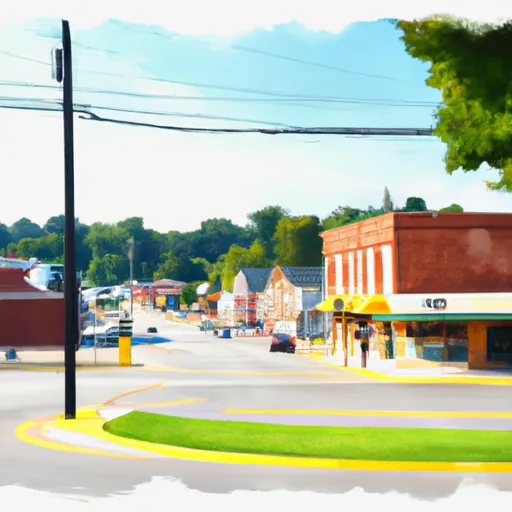-
 Snoflo Premium
Snoflo Premium
Get unlimited access to all our content
With no Ad interruptions! - Start Your Free Trial Login with existing account
Bradfordsville
Eden Index
Climate
7.8
•
Recreation
2.8
•
Community
•
Safeguard
4.1/10

Bradfordsville is a small town located in Marion County, Kentucky. The town experiences a humid subtropical climate, with hot and humid summers and cool winters. The town has several streams and creeks, including the Rolling Fork River, which is a popular spot for fishing and boating. The hydrology constituents of the town are primarily agricultural, with several farms and livestock operations in the area. Outdoor recreation opportunities in the area include hiking and camping at nearby parks, such as Green River Lake State Park and Mammoth Cave National Park. Additionally, there are numerous opportunities for hunting and fishing in the surrounding countryside.
What is the Eden Index?
The Snoflo Eden Index serves as a comprehensive rating system for regions, evaluating their desirability through a holistic assessment of climate health, outdoor recreation opportunities, and natural disaster risk, acknowledging the profound impact of these factors on livability and well-being.
Climate Health Indicator (CHI): 7.8
Bradfordsville receives approximately
1312mm of rain per year,
with humidity levels near 81%
and air temperatures averaging around
13°C.
Bradfordsville has a plant hardyness factor of
6, meaning
plants and agriculture in this region thrive during a short period during spring and early summer. Most
plants will die off during the colder winter months.
By considering the ideal temperature range, reliable water supplies, clean air, and stable seasonal rain or snowpacks, the Climate Health Indicator (CHI) underscores the significance of a healthy climate as the foundation for quality living.
A healthy climate is paramount for ensuring a high quality of life and livability in a region, fostering both physical well-being and environmental harmony. This can be characterized by ideal temperatures, reliable access to water supplies, clean air, and consistent seasonal rain or snowpacks.
Weather Forecast
Streamflow Conditions
Lower Ohio-Salt
Area Rivers
Lower Ohio-Salt
Snowpack Depths
Lower Ohio-Salt
Reservoir Storage Capacity
Lower Ohio-Salt
Groundwater Levels
Recreational Opportunity Index (ROI): 2.8
The Recreational Opportunity Index (ROI) recognizes the value of outdoor recreational options, such as parks, hiking trails, camping sites, and fishing spots, while acknowledging that climate plays a pivotal role in ensuring the comfort and consistency of these experiences.
Access to outdoor recreational opportunities, encompassing activities such as parks, hiking, camping, and fishing, is crucial for overall well-being, and the climate plays a pivotal role in enabling and enhancing these experiences, ensuring that individuals can engage in nature-based activities comfortably and consistently.
Camping Areas
| Campground | Campsites | Reservations | Toilets | Showers | Elevation |
|---|---|---|---|---|---|
| Skull Island - Chickamauga Lake | None | 717 ft | |||
| Lillydale - Dale Hollow Lake | 114 | 653 ft | |||
| Paul Ogle Riverfront Park | None | 451 ft | |||
| Possum Creek RV - Chickamauga Lake | None | 774 ft | |||
| Versailles State Park | 225 | 965 ft | |||
| Dale Hollow State Park | 145 | 1,037 ft | |||
| Sale Creek - Chickamauga Lake | 50 | 707 ft | |||
| Obey River - Dale Hollow Lake | 131 | 658 ft | |||
| Harrison Bay State Park | 149 | 721 ft | |||
| Chester Frost Park | None | 750 ft |
Nearby Ski Areas
Catastrophe Safeguard Index (CSI):
The Catastrophe Safeguard Index (CSI) recognizes that natural disaster risk, encompassing floods, fires, hurricanes, and tornadoes, can drastically affect safety and the overall appeal of an area.
The level of natural disaster risk in a region significantly affects safety and the overall livability, with climate change amplifying these risks by potentially increasing the frequency and intensity of events like floods, fires, hurricanes, and tornadoes, thereby posing substantial challenges to community resilience and well-being.
Community Resilience Indicator (CRI):
The Community Resilience Indicator (CRI) recognizes that education, healthcare, and socioeconomics are crucial to the well-being of a region. The CRI acknowledges the profound impact of these elements on residents' overall quality of life. By evaluating educational resources, healthcare accessibility, and economic inclusivity, the index captures the essential aspects that contribute to a thriving community, fostering resident satisfaction, equity, and social cohesion.

